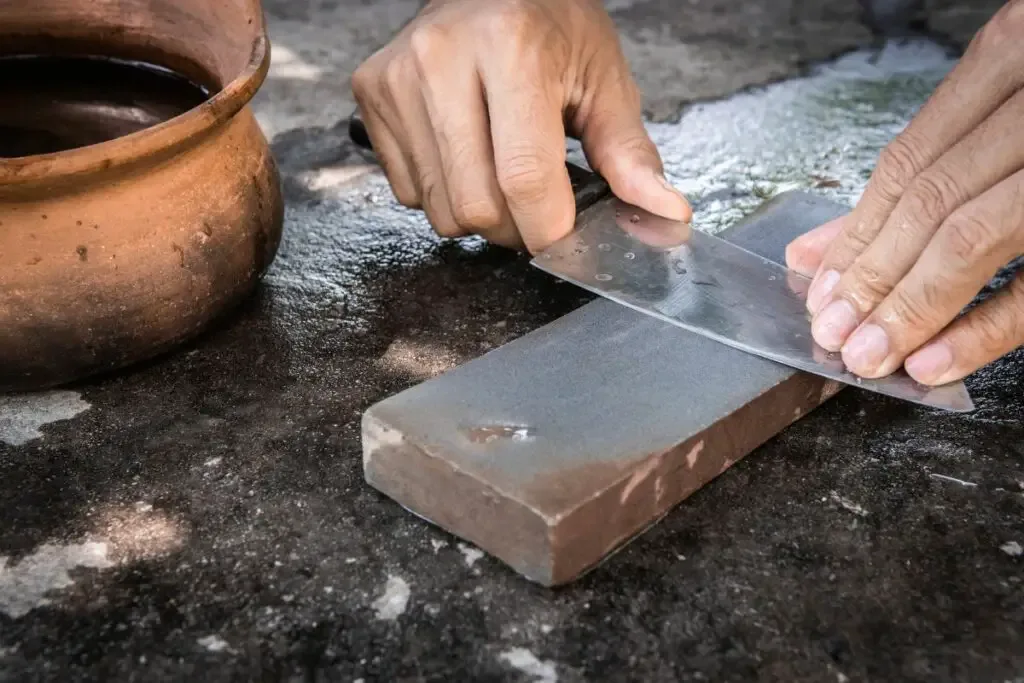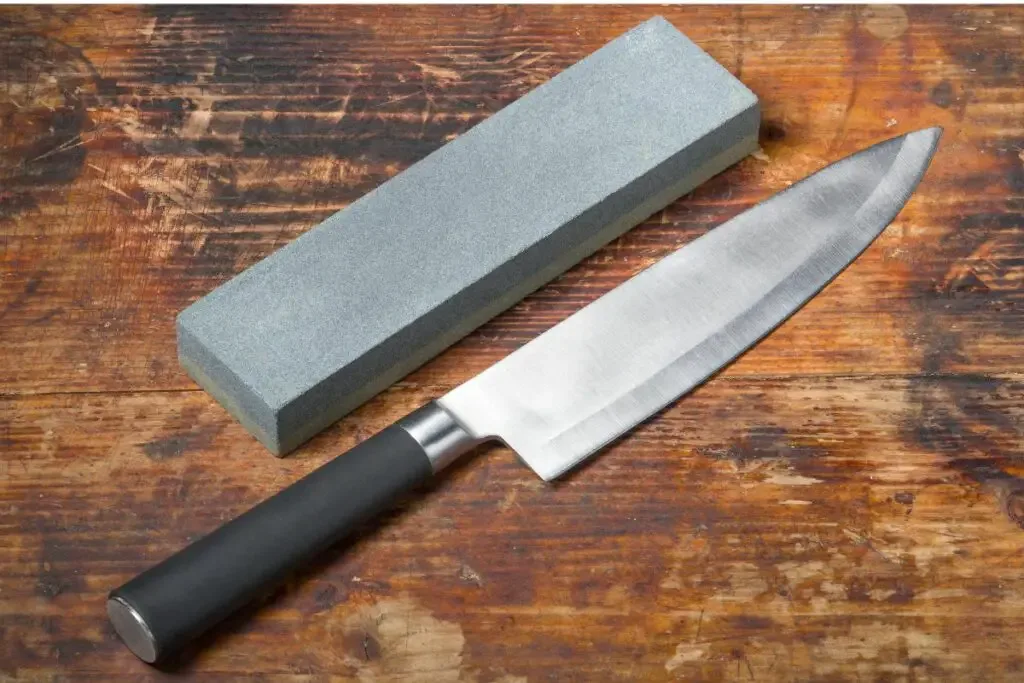As an Amazon Associate, we earn from qualifying purchases with no additional costs for you.
Whetstones have been an essential tool in many a craftsman’s arsenal for centuries, but they have recently found themselves at the heart of a heated debate. In today’s age of information (and misinformation), a pressing question has emerged: Are whetstones dangerous?
Whetstones are not dangerous to use. Natural whetstones emit no dangerous radiation and are not harmful to humans. A tiny amount of natural radiation is present in all natural stones, including whetstones, but radiation of this type is harmless. Whetstones are entirely safe if used correctly.
The whispers of radiation emanating from these sharpening stones have caused a stir. We will explore the matter, shed light on the truths, and dispel the myths surrounding the safety of using whetstones. So, whether you’re a general knife user, a DIY enthusiast, or just a curious reader, join us on this enlightening journey to uncover the real story behind the stones.
Using whetstones is a fantastic way to keep your knives sharp. If you want to try using whetstones for yourself, you can find a great option here (Amazon link).
Are Whetstones Safe To Use?

The question of whether or not whetstones are safe to use is hotly debated, as a story has emerged in the knife and blade community that whetstones emit radiation and are not safe to handle. This leads many to wonder if whetstones are dangerous or if the rumors should be ignored altogether.
When used correctly, whetstones are not dangerous. In fact, they are one of the most reliable and time-tested methods for sharpening knives. Let’s dive deeper into this topic and address the concerns that have surfaced.
Do Whetstones Emit Radiation?
One of the primary misconceptions surrounding whetstones is the fear of radiation. As we’ve discussed earlier in this article, all rocks and soil derived from rock contain naturally occurring radioactive materials (NORM) to some extent.
However, the radiation levels from most whetstones are negligible and are often overshadowed by the natural background radiation we’re exposed to daily.
It’s essential to understand that the mere presence of radiation doesn’t equate to danger. The sun, for instance, emits radiation, but it’s also a vital source of life.
Dangers Of Using Whetstones
Another concern might be the physical act of sharpening itself. Like any tool, whetstones require a certain level of skill and understanding to use safely. The danger isn’t inherent in the stone but in how it’s used. With proper technique, attention to detail, and respect for the tool, the risk of injury is minimal.
When compared to other sharpening methods, whetstones offer a controlled and precise way to hone a blade. Electric sharpeners (Amazon link), while convenient, can sometimes remove more material than necessary, reducing the lifespan of the knife.
Whetstones allow for a more measured approach, ensuring that only the necessary amount of material is removed.
Like any skill, sharpening with a whetstone becomes safer and more effective with experience. For those new to the process, it’s advisable to start with a less expensive knife, practice the technique, and gradually move on to more valuable blades.
Over time, the user becomes more attuned to the feel of the blade against the stone, understanding the nuances and achieving a razor-sharp edge safely.
Whetstones are not only safe but are also one of the most effective methods for sharpening knives. The key lies in understanding the tool, practicing the technique, and approaching the process with respect and care. The next time you pick up a whetstone, do so with confidence, knowing that it’s a trusted ally in your knife maintenance toolkit.
TIP: Whetstones are not inherently dangerous to use, but they can become dangerous to use if not properly maintained. To learn how to maintain your whetstones well, check out this article:
14 Care Tips For Better & Longer Endurance Of Your Whetstone
Natural Stone Radiation: Myth or Reality?

All rocks and soils, to some extent, contain naturally occurring radioactive materials (NORM). These materials emit a certain level of radiation, which has been a part of our environment since the earth’s formation.
In the case of whetstones, certain types, especially those sourced from specific regions, might have slightly elevated levels of NORM. However, the keyword here is “slightly.”
To put this in perspective, bananas contain potassium, and a tiny fraction of potassium is radioactive. This phenomenon is playfully termed the “banana equivalent dose” in the radiation world.
While it is true that eating a banana exposes you to radiation, the amount is so minuscule that it’s harmless. Similarly, the radiation from a natural whetstone, even if detectable, is often at levels that pose no significant health risk.
The radiation from natural whetstones (Amazon link), in the vast majority of cases, is negligible and poses no more risk than many everyday items we encounter.
Addressing Common Whetstone Fears and Misconceptions

In an age where information is just a click away, it’s paradoxical how misconceptions can spread as rapidly as facts. The safety of whetstones, particularly concerning radiation, has not been immune to this trend.
By shedding light on these misconceptions, we hope to replace fear with understanding. Whetstones, whether natural or synthetic, have been used for centuries to hone blades to perfection. With a balanced perspective and informed choices, they can continue to be a cherished tool in our toolkit, free from the shadows of misconceptions.
Let’s address and debunk some of the most common fears and misconceptions surrounding these sharpening stones.
All Radiation is Harmful
One of the most prevalent misconceptions is that all radiation is harmful. In reality, radiation is all around us. From the sun’s rays to the minerals in the earth, radiation is a natural part of our environment.
It’s the dose and duration that determine its impact. The radiation levels from most whetstones are minuscule and are often overshadowed by the natural background radiation we’re exposed to daily.
Geiger Counters are the Ultimate Truth
While Geiger counters are fantastic tools for detecting radiation, they don’t always tell the whole story.
A radiation reading might indicate the presence of radiation, but without context, it’s like knowing the temperature without knowing if it’s Celsius or Fahrenheit. It is essential to understand the type and intensity of radiation before drawing conclusions.
Synthetic Whetstones are Safer
Given the buzz around natural stone radiation, one might assume that synthetic whetstones are the safer bet. However, both natural and synthetic stones have their pros and cons.
Radiation is a concern exclusive to natural stones, and many synthetic stones (Amazon link) are perfectly safe and effective.
Radiation Equals Poor Quality
A stone emitting radiation doesn’t necessarily mean it’s of inferior quality. Many high-quality natural stones, prized for their sharpening abilities, may emit trace amounts of radiation.
It’s crucial to differentiate between the stone’s sharpening properties and any unrelated natural radiation.
Avoiding Natural Stones is the Solution
In the wake of the radiation discussions, some might be tempted to avoid natural whetstones altogether. However, this would be an overreaction. With proper knowledge and perspective, one can safely use and enjoy the benefits of natural whetstones without undue concern.
Whetstones are Only for Professionals
Another misconception that often surfaces is the notion that whetstones are reserved solely for professional chefs or craftsmen. In reality, whetstones are versatile tools that can be used by anyone, from a home cook to a hobbyist.
The key is to approach the sharpening process with patience and a willingness to learn. With a plethora of tutorials and guides available, mastering the art of sharpening with a whetstone is within reach for anyone interested. It’s not about professional status but about the dedication to maintaining and caring for one’s tools.
TIP: Whetstones are not only for professionals, but it is critical to buy the right whetstones for your purposes. To learn more about which whetstone to use and when, check out this article:
Complete GUIDE About Whetstone Grit: Levels & What To Buy
Conclusion
Radiation is all around us, and its presence in whetstones is no more alarming than its existence in many everyday items. By approaching concerns with a critical mind and relying on scientific evidence, we can dispel myths and embrace the truth.
Whetstones, whether natural or synthetic, remain an invaluable tool for craftsmen, chefs, and enthusiasts alike. Their ability to transform a dull blade into a precision instrument is nothing short of magic. The next time you pick up a whetstone, remember the facts, trust the science, and enjoy the art of sharpening with confidence and joy.
